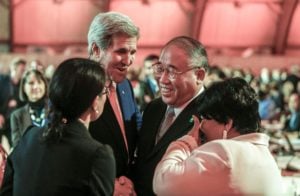This year, the climate and biodiversity agendas are set to come together on the global stage as never before. With China hosting its first multilateral environmental summit (the UN biodiversity conference, COP15), this is an important moment for discussion on how China can engage. A key lever for changing environmental outcomes is changing how money is spent. Sustainable investing is making waves across all asset classes in financial markets. And China has become a leader of the global green finance agenda.
In partnership with the Finance for Biodiversity Initiative (F4B), China Dialogue has published a series of articles exploring the systemic financial risk posed by biodiversity loss, how financial institutions have a unique responsibility to address it, what they are already doing, and the financial opportunities involved.
Biodiversity is not considered in the vast majority of financial decisions taken globally today. As a result, financial institutions are increasingly exposing themselves to risks both from harming nature, and as a result of their dependence on nature benefits that are vulnerable.
In this 27 January webinar we drew upon China’s leading role in green finance to explore what leadership could look like around the nexus of biodiversity and finance, where progress is being made, and how further action could help deliver results.
Speakers:
Isabel Hilton (chair) – China Dialogue
Deborah Lehr – Paulson Institute
Kevin Gallagher – Boston University
Dr Christoph Nedopil Wang – IIGF Green Belt and Road Initiative Center
Ma Jun – Institute of Public and Environmental Affairs
Marianne Haahr – Green Digital Finance Alliance
Bernice Lee – Hoffmann Centre for Sustainable Resource Economy
Some interesting excerpts
Deborah Lehr:
05:49: There’s still not agreed upon taxonomy for what “green” includes when it comes to investments. Fortunately, China took an important step forward when the People’s Bank of China agreed in June 2020 to exclude “clean coal” from qualifying as a green investment. While green finance development has indeed been robust, China still has significant challenges ahead in making the necessary adjustments of its economy to reach carbon neutrality.
07:55: Harnessing the power of markets can protect our environment and prevent its rapid destruction. In financial terms, bats, bees and birds are a valuable asset. Take for example the service provided by pollinators. […] A total loss of these species could lead to a drop in annual agricultural output of more than US$200 billion. Add the secondary service of pollinating non-food crops such as alfalfa, the main feed for cattle, and the impact rises to more than US$500 billion a year.
Kevin Gallagher:
18:21: We recommended that a mitigation hierarchy with Chinese characteristics be a core part of the BRI as well as strategic environmental assessments for each project, which are currently relying on host countries to provide that information.
20:30: China should create a biodiversity fund similar to the fund they have on climate change [the US$3.1 billion South-South Climate Cooperation Fund]. This could be used to invest in biodiversity in BRI countries. It could be used for compensation mechanisms through a mitigation hierarchy. It could also be used as part of debt-for-climate swaps and debt-for-nature swaps. Let’s remember that China was the real pioneer when it came to green bonds, launching a number of incredible initiatives. […] China could also be a pioneer in nature-performance bonds for the Chinese markets and for the BRI.
Christoph Nedopil Wang:
25:36: With climate considerations I think we’re all aware that one of the most important measures to evaluate climate risks or climate impacts is CO2 emissions, or the equivalent of CO2 emissions. The big question for biodiversity is: do we have a similar measure to understand the impact that specific projects or industries have on biodiversity?
47:41: There is a need to understand how we can apply some of the redlining seen in China to BRI projects. The big challenge is: who is overseeing that? […] Is it the host countries […] or the Chinese investors? […] We are very far away from including biodiversity through regulation into the decision-making process. Now there are initiatives, and there is also the Green Development Guidance, which was published by the Belt and Road Initiative Green Coalition with the support from MEE [Ministry of Ecology and Environment] – and I had the honour to lead a lot of the work – that for the first time really include biodiversity consideration as an environmental risk, where we developed this traffic light system that allows for all types of projects to be evaluated according to their pollution risk, climate risk and biodiversity risk, so investors can more easily understand whether they have any environmental risk exposure. […] The real big question is: how can this traffic light system be implemented and ensured?
Ma Jun:
54:16: China has designated a quarter of its territory to redline zones, but the maps are not quite accessible. What we are doing is putting these on a digital map, including the sensitive regions and all the protected zones, [like] national parks. Because of the mapping and data policies in China, we won’t publish before the government publishes more detailed maps. But we can calculate all of this and overlay it with more than four million companies, which we’ve put on the digital map. So with this, we can start calculating their biodiversity footprint. […] For nearly 600 brands, we’re tracking their supply chain performance, and I think there’s a chance to integrate that into the green supply chain.
01:08:13: Blockchain is obviously a very big innovative solution. At this moment, we haven’t been able to fully adopt that [in China]. We developed something called the eco-chain, which helped to link different stakeholders together. […] There are new technologies emerging where you can use the data, but you may not actually access all of the data. This type of technology may eventually be very helpful.
Marianne Haahr:
36:37: What we are seeing in China is digitisation of finance extremely rapidly. China launched the Blockchain Services Network in April last year, which is one of the world’s largest blockchain trading platforms. […] Going forward, quite a lot of the countries that want to trade with China will do that on this blockchain platform. […] We have a perfect moment because China just changed its Forestry Law, which prohibits imports of timber if you know that it’s illegally logged. […] So a bank could actually link their clients’ transactions to deforestation, […] and you could overlay it with satellite data, etc. And that would pave the way for financial institutions being able to set net-zero deforestation targets.
01:05:19: Sovereign debt is quite a large portion of international capital markets. If we can manage to green that and make that nature-sensitive, then we have come quite a long way. The thinking has matured since the 80s, so that now we would like to have that in [debt-for]-nature swaps and “nature performance bonds”-type structures, where you can put in more accountability, both to those that participate but also to populations, so your behaviour is rewarded according to your behavioural changes. China has an opportunity to leverage its front-runner position in digital technology to [give parts of the tasks of] monitoring and validation to technology.
Bernice Lee:
40:11: While it is very encouraging to see many blossoming ideas, initiatives, targets and aspirations around financing for nature, the reality is it’s not connecting and it’s not connected. The question is how do we make sure all of these financing ideas are really grounded in the reality of specific place-based implementation. […] The danger at the moment is that a lot of the nature-based solutions and associated financial mechanisms are seen as silver bullets or get-out-of-jail-free cards for large emitters.
44:48: The government is in a position in some sense to mandate some of the [biodiversity] spending including through public sector pay. [For example,] 20% of public sector pay in China could be only redeemable via a nature-based economy. […] The point is, we can create a system where we use the state-owned nature of the Chinese economy to the advantage of the promotion of the green economy.
Copyright notice
This video is released under the Creative Commons Attribution Non-Commercial No Derivatives licence. For a copy of the video file, please contact: [email protected].






![The Indus at the site of the proposed Diamer-Basha dam [image by: Water and Power Development Authority, Pakistan]](https://dialogue.earth/content/uploads/2020/07/Indus_Diamer_Basha_Dam_Site_Image_WAPDA-300x169.jpg)
